Ti2CTx MXene as a Saturable Absorber for Passively Q-Switched Solid-State Lasers
Abstract
1. Introduction
2. Experimental
2.1. Fabrication of Ti2CTx-SAs
2.2. Characterization of Ti2CTx-SAs
2.3. Q-Switched Solid-State Lasers with Ti2CTx-SAs
3. Results and Discussion
4. Conclusions
Author Contributions
Funding
Institutional Review Board Statement
Informed Consent Statement
Data Availability Statement
Acknowledgments
Conflicts of Interest
References
- Naguib, M.; Kurtoglu, M.; Presser, V.; Lu, J.; Niu, J.J.; Heon, M.; Hultman, L.; Gogotsi, Y.; Barsoum, M.W. Two-dimensional nanocrystals produced by exfoliation of Ti3AlC2. Adv. Mater. 2011, 23, 4248–4253. [Google Scholar] [CrossRef]
- Hantanasirisakul, K.; Zhao, M.Q.; Urbankowski, P.; Halim, J.; Anasori, B.; Kota, S.; Ren, C.E.; Barsoum, M.W.; Gogotsi, Y. Fabrication of Ti3C2Tx MXene transparent thin films with tunable optoelectronic properties. Adv. Electron. Mater. 2016, 2, 160050–160057. [Google Scholar] [CrossRef]
- Jiang, X.T.; Liu, S.X.; Liang, W.Y.; Luo, S.J.; He, Z.L.; Ge, Y.Q.; Wang, H.D.; Cao, R.; Zhang, F.; Wen, Q.; et al. Broadband nonlinear photonics in few-layer MXene Ti3C2Tx (T=F, O, or OH). Laser Photon. Rev. 2018, 12, 1700229–1700239. [Google Scholar] [CrossRef]
- Feng, A.; Hou, T.; Jia, Z.; Zhang, Y.; Zhang, F.; Wu, G. Preparation and characterization of epoxy resin filled with Ti3C2Tx MXene nanosheets with excellent electric conductivity. Nanomaterials 2020, 10, 162. [Google Scholar] [CrossRef] [PubMed]
- Lipatov, A.; Alhabeb, M.; Lukatskaya, M.R.; Boson, A.; Gogotsi, Y.; Sinitskii, A. Effect of synthesis on quality, electronic properties and environmental stability of individual monolayer Ti3C2 MXene flakes. Adv. Electron. Mater. 2016, 2, 1600255–1600264. [Google Scholar] [CrossRef]
- Li, N.; Xie, Y.; Peng, S.T.; Xiong, X.; Han, K. Ultra-lightweight Ti3C2Tx MXene modified separator for Li-S batteries: Thickness regulation enabled polysulfide inhibition and lithium ion transportation. J. Energy Chem. 2020, 42, 116–125. [Google Scholar] [CrossRef]
- Rao, Q.S.; Liao, S.Y.; Huang, X.-W.; Li, Y.-Z.; Liu, Y.-D.; Min, Y.-G. Assembly of MXene/PP separator and its enhancement for Ni-Rich LiNi0.8Co0.1Mn0.1O2 electrochemical performance. Polymers 2020, 12, 2192. [Google Scholar] [CrossRef]
- Zhang, H.; Wang, Z.; Zhang, Q.; Wang, F.; Liu, Y. Ti3C2 MXenes nanosheets catalyzed highly efficient electrogenerated chemiluminescence biosensor for the detection of exosomes. Biosens. Bioelectron. 2019, 124, 184–190. [Google Scholar] [CrossRef]
- Xu, Y.; Ang, Y.S.; Wu, L.; Ang, L.K. High sensitivity surface plasmon resonance sensor based on two-dimensional MXene and transition metal dichalcogenide: A theoretical study. Nanomaterials 2019, 9, 165. [Google Scholar] [CrossRef]
- Feng, T.C.; Li, X.H.; Guo, P.L.; Zhang, Y.; Liu, J.S.; Zhang, H. MXene: Two dimensional inorganic compounds, for generation of bound state soliton pulses in nonlinear optical system. Nanophotonics 2020, 9, 2505–2513. [Google Scholar] [CrossRef]
- Adelman, M.R.; Tsai, L.J.; Tangchitnob, E.P.; Kahn, B.S. Laser technology and applications in gynaecology. J. Obstet. Gynaecol. 2013, 33, 225–231. [Google Scholar] [CrossRef] [PubMed]
- Barnes, N.P. Remote sensing of planet earth challenges for solid-state lasers. Laser Phys. 1998, 8, 25–28. [Google Scholar]
- Chen, Y.F.; Lee, C.C.; Hsiao, J.Q.; Huang, H.Y.; Tsou, C.H.; Liang, H.C.; Huang, K.F. Exploiting a monolithic passively Q-switched Nd:YAG laser to mimic a single neuron cell under periodic stimulation. Opt. Lett. 2020, 45, 4032–4035. [Google Scholar] [CrossRef] [PubMed]
- Phuoc, T.X. Laser-induced spark ignition fundamental and applications. Opt. Laser Eng. 2006, 44, 351–397. [Google Scholar] [CrossRef]
- Zayhowski, J.J. Passively Q-switched Nd:YAG microchip lasers and applications. J. Alloys. Compd. 2000, 303, 393–400. [Google Scholar] [CrossRef]
- Luo, H.; Tang, D.Y.; Xie, G.Q.; Tan, W.D.; Zhang, H.J.; Yu, H.H. Diode-pumped passively mode-locked Nd:CLNGG laser. Opt. Commun. 2009, 282, 291–293. [Google Scholar] [CrossRef]
- Miao, J.G.; Wang, B.S.; Peng, J.Y.; Tan, H.M.; Bian, H.K. Efficient diode-pumped passively Q-switched laser with Nd:YAG/Cr:YAG composite crystal. Opt. Laser Technol. 2008, 40, 137–141. [Google Scholar] [CrossRef]
- Sulc, J.; Jelinkova, H.; Nejezchleb, K.; Skoda, V. Nd: YAG/V: YAG monolithic microchip laser operating at 1.3 μm. Opt. Mater. 2007, 30, 50–53. [Google Scholar] [CrossRef]
- Pavel, N.; Saikawa, J.; Kurimura, S.; Taira, T. High average power diode end-pumped composite Nd: YAG laser passively Q-switched by Cr4+:YAG saturable absorber. Jpn. J. Appl. Phys. 2001, 40, 1253–1259. [Google Scholar] [CrossRef]
- Sun, Z.P.; Martinez, A.; Wang, F. Optical modulators with 2D layered materials. Nat. Photonics 2016, 10, 227–238. [Google Scholar] [CrossRef]
- Xu, J.L.; Li, X.L.; Wu, Y.Z.; Hao, X.P.; He, J.L.; Yang, K.J. Graphene saturable absorber mirror for ultra-fast-pulse solid-state laser. Opt. Lett. 2011, 36, 1948–1950. [Google Scholar] [CrossRef]
- Zhang, H.; Lu, S.B.; Zheng, J.; Du, J.; Wen, S.C.; Tang, D.Y.; Loh, K.P. Molybdenum disulfide (MoS2) as a broadband saturable absorber for ultra-fast photonics. Opt. Express 2014, 22, 7249–7260. [Google Scholar] [CrossRef] [PubMed]
- Liu, H.; Sun, Z.; Wang, X.; Wang, Y.G.; Cheng, G.H. Several nanosecond Nd:YVO4 lasers Q-switched by two dimensional materials: Tungsten disulfide, molybdenum disulfide, and black phosphorous. Opt. Express 2017, 25, 6244–6252. [Google Scholar] [CrossRef] [PubMed]
- Tang, P.H.; Zhang, X.Q.; Zhao, C.J.; Wang, Y.; Zhang, H.; Shen, D.Y.; Wen, S.C.; Tang, D.Y.; Fan, D.Y. Topological insulator: Bi2Te3 saturable absorber for the passive Q-Switching operation of an in-band pumped 1645-nm Er:YAG ceramic laser. IEEE Photonics J. 2013, 5, 1500707–1500715. [Google Scholar] [CrossRef]
- Ma, J.; Lu, S.; Guo, Z.; Xu, X.; Zhang, H.; Tang, D.; Fan, D. Few-layer black phosphorus based saturable absorber mirror for pulsed solid-state lasers. Opt. Express. 2015, 23, 22643–22648. [Google Scholar] [CrossRef]
- Wang, J.; Wang, Y.G.; Chen, Z.D.; Yang, X.G.; Lv, R.D. CH3NH3PbI3 perovskite thin films as a saturable absorber for a passively Q-switched Nd:YAG laser. J. Mater. Chem. C 2019, 7, 5047–5050. [Google Scholar] [CrossRef]
- Wen, Q.; Zhang, X.J.; Wang, Y.G.; Wang, Y.S.; Niu, H.B. Passively Q-switched Nd:YAG laser with graphene oxide in heavy water. IEEE Photonics J. 2014, 6, 1500706–1500713. [Google Scholar] [CrossRef]
- Tang, C.Y.; Cheng, P.K.; Tao, L.; Long, H.; Zeng, L.H.; Wen, Q.; Tsang, Y.H. Passively Q-switched Nd: YVO4 laser using WS2 saturable absorber fabricated by radio frequency magnetron sputtering deposition. J. Lightwave Technol. 2017, 35, 4120–4124. [Google Scholar] [CrossRef]
- Xu, N.; Li, H.B.; Gan, Y.Y.; Chen, H.L.; Li, W.J.; Zhang, F.; Jiang, X.T.; Shi, Y.H.; Liu, J.F.; Wen, Q.; et al. Zero-dimensional MXene-based optical devices for ultrafast and ultranarrow photonics applications. Adv. Sci. 2020, 7, 2002209–2002221. [Google Scholar] [CrossRef]
- Sun, X.; Zhang, B.; Yan, B.; Li, G.; Nie, H.; Yang, K.; Zhang, C.; He, J. Few-layer Ti3C2Tx (T = O, OH, or F) saturable absorber for a femtosecond bulk laser. Opt. Lett. 2018, 43, 3862–3865. [Google Scholar] [CrossRef]
- Li, J.; Zhang, Z.L.; Du, L.; Miao, L.L.; Yi, J.; Huang, B.; Zou, Y.H.; Zhao, C.J.; Wen, S.C. Highly stable femtosecond pulse generation from a MXene Ti3C2Tx (T = F, O, or OH) mode-locked fiber laser. Photonics Res. 2019, 7, 260–264. [Google Scholar] [CrossRef]
- Jiang, X.T.; Li, W.J.; Hai, T.; Yue, R.; Chen, Z.W.; Lao, C.S.; Ge, Y.Q.; Xie, G.Q.; Wen, Q.; Zhang, H. Inkjet-printed MXene micro-scale devices for integrated broadband ultrafast photonics. NPJ 2D Mater. Appl. 2019, 3, 1–9. [Google Scholar] [CrossRef]
- Jhon, Y.I.; Koo, J.; Anasori, B.; Seo, M.; Lee, J.H.; Gogotsi, Y.; Jhon, Y.M. Metallic MXene saturable absorber for femtosecond mode-locked lasers. Adv. Mater. 2017, 29, 1702496–1702504. [Google Scholar] [CrossRef] [PubMed]
- Huang, W.C.; Ma, C.Y.; Li, C.; Zhang, Y.; Hu, L.P.; Chen, T.T.; Tang, Y.F.; Ju, J.F.; Zhang, H. Highly stable MXene (V2CTx)-based harmonic pulse generation. Nanophotonics 2020, 9, 2577–2585. [Google Scholar] [CrossRef]
- Li, G.Q.; Li, T.; Qiao, W.C.; Feng, T.L.; Feng, C.Y.; Zhao, J.; Li, G.Q.; Zhao, S.Z. Passively Q-switched Er:Lu2O3 laser with MXene material Ti4N3Tx (T = F, O, or OH) as a saturable absorber. Opt. Lett. 2020, 45, 4256–4259. [Google Scholar] [CrossRef] [PubMed]
- Cao, L.; Chu, H.; Pan, H.; Wang, R.; Li, Y.; Zhao, S.; Li, D.; Zhang, H.; Li, D. Nonlinear optical absorption features in few-layered hybrid Ti3C2(OH)2/Ti3C2F2 MXene for optical pulse generation in the NIR region. Opt. Express. 2020, 28, 31499–31509. [Google Scholar] [CrossRef] [PubMed]
- Yi, J.; Du, L.; Li, J.; Yang, L.L.; Hu, L.Y.; Huang, S.H.; Dong, Y.C.; Miao, L.L.; Wen, S.C.; Mochalin, V.N.; et al. Unleashing the potential of Ti2CTx MXene as a pulse modulator for mid-infrared fiber lasers. 2D Mater. 2019, 6, 045038–045048. [Google Scholar] [CrossRef]
- Shi, Y.H.; Xu, N.; Wen, Q. Ti2CTx (T=O, OH or F) nanosheets as new broadband saturable absorber for ultrafast photonics. J. Lightwave Technol. 2020, 38, 1975–1980. [Google Scholar] [CrossRef]
- Sun, Y.J.; Lee, C.K.; Xu, J.L.; Zhu, Z.J.; Wang, Y.Q.; Gao, S.F.; Xia, H.P.; You, Z.Y.; Tu, C.Y. Passively Q-switched tri-wavelength Yb3+:GdAl3(BO3)4 solid-state laser with topological insulator Bi2Te3 as saturable absorber. Photonics Res. 2015, 3, A97–A101. [Google Scholar] [CrossRef]
- Li, H.P.; Li, X.R.; Liang, J.J.; Chen, Y.S. Hydrous RuO2-decorated MXene coordinating with silver nanowire inks enabling fully printed micro-supercapacitors with extraordinary volumetric performance. Adv. Energy Mater. 2019, 9, 1803987–1804000. [Google Scholar] [CrossRef]
- Liu, G.Z.; Shen, J.; Ji, Y.F.; Liu, Q.; Liu, G.P.; Yang, J.; Jin, W.Q. Two-dimensional Ti2CTx MXene membranes with integrated and ordered nanochannels for efficient solvent dehydration. J. Mater. Chem. A. 2019, 7, 12095–12104. [Google Scholar] [CrossRef]
- Ang, Y.S.; Sultan, S.; Zhang, C. Nonlinear optical spectrum of bilayer graphene in the terahertz regime. Appl. Phys. Lett. 2010, 97, 243110–243114. [Google Scholar] [CrossRef]
- Shareef, S.; Ang, Y.S.; Zhang, C. Room-temperature strong terahertz photon mixing in graphene. J. Opt. Soc. Am. B 2012, 29, 274–279. [Google Scholar] [CrossRef]
- Belanger, P.A. Beam propagation and the ABCD ray matrices. Opt. Lett. 1991, 16, 196–198. [Google Scholar] [CrossRef] [PubMed]
- Degnan, J.J. Theory of optimally coupled Q-switched laser. IEEE J. Quantum Electron. 1989, 25, 214–220. [Google Scholar] [CrossRef]
- Zayhowski, J.J. Microchip lasers. Opt. Mater. 1999, 11, 255–267. [Google Scholar] [CrossRef]
- Nakazawa, M.; Nakahara, S.; Hirooka, T.; Yoshida, M. Polymer saturable absorber materials in the 1.5 μm band using poly-methyl-methacrylate and polystyrene with single-wall carbon nanotubes and their application to a femtosecond laser. Opt. Lett. 2006, 31, 915–917. [Google Scholar] [CrossRef]
- Ng, E.K.; Lau, K.Y.; Lee, H.K.; Abu Bakar, M.H.; Kamil, Y.M.; Omar, M.F.; Mahdi, M.A. Saturable absorber incorporating graphene oxide polymer composite through dip coating for mode-locked fiber laser. Opt. Mater. 2020, 100, 109619–109627. [Google Scholar] [CrossRef]
- Martinez, A.; Al Araimi, M.; Dmitriev, A.; Lutsyk, P.; Li, S.; Mou, C.; Rozhin, A.; Sumetsky, M.; Turitsyn, S. Low-loss saturable absorbers based on tapered fibers embedded in carbon nanotube/polymer composites. APL Photonics 2017, 2, 126103–126113. [Google Scholar] [CrossRef]
- Wang, Y.G.; Chen, H.R.; Wen, X.M.; Hsieh, W.F.; Tang, J. A highly efficient graphene oxide absorber for Q-switched Nd:GdVO4 lasers. Nanotechnology 2011, 22, 455203–455207. [Google Scholar] [CrossRef][Green Version]
- Zhang, R.; Zhang, Y.; Yu, H.; Zhang, H.; Yang, R.; Yang, B.; Liu, Z.; Wang, J. Broadband black phosphorus optical modulator in the spectral range from visible to mid-infrared. Adv. Opt. Mater. 2015, 3, 1787–1792. [Google Scholar] [CrossRef]
- Li, P.X.; Zhang, G.J.; Zhang, H.; Zhao, C.J.; Chi, J.J.; Zhao, Z.Q.; Yang, C.; Hu, H.W.; Yao, Y.F. Q-Switched Mode-locked Nd:YVO4 laser by topological insulator Bi2Te3 saturable absorber. IEEE Photonics Technol. Lett. 2014, 26, 1912–1915. [Google Scholar] [CrossRef]
- Yu, H.; Zhang, H.; Wang, Y.; Zhao, C.; Wang, B.; Wen, S.; Zhang, H.; Wang, J. Topological insulator as an optical modulator for pulsed solid-state lasers. Laser Photon. Rev. 2013, 7, L77–L83. [Google Scholar] [CrossRef]
- Su, X.; Zhang, B.; Wang, Y.; He, G.; Li, G.; Lin, N.; Yang, K.; He, J.; Liu, S. Broadband rhenium disulfide optical modulator for solid-state lasers. Photonics Res. 2018, 6, 498–505. [Google Scholar] [CrossRef]
- Wang, S.; Yu, H.; Zhang, H.; Wang, A.; Zhao, M.; Chen, Y.; Mei, L.; Wang, J. Broadband few-layer MoS2 saturable absorbers. Adv. Mater. 2014, 26, 3538–3544. [Google Scholar] [CrossRef]
- Yang, Q.; Zhang, F.; Zhang, N.Y.; Zhang, H. Few-layer MXene Ti3C2Tx (T = F, O, or OH) saturable absorber for visible bulk laser. Opt. Mater. Express. 2019, 9, 1795–1802. [Google Scholar] [CrossRef]
- Zhao, M.F.; Zhang, Z.M.; Feng, X.Y.; Zong, M.Y.; Liu, J.; Xu, X.D.; Zhang, H. High repetition rate passively Q-switched laser on Nd:SRA at 1049 nm with MXene Ti3C2Tx. Chin. Opt. Lett. 2020, 18, 041401–041405. [Google Scholar] [CrossRef]
- Feng, X.Y.; Ding, B.Y.; Liang, W.Y.; Zhang, F.; Ning, T.Y.; Liu, J.; Zhang, H. MXene Ti3C2Tx absorber for a 1.06 μm passively Q-switched ceramic laser. Laser Phys. Lett. 2018, 15, 085805–085811. [Google Scholar] [CrossRef]
- Wang, C.; Peng, Q.Q.; Fan, X.W.; Liang, W.Y.; Zhang, F.; Liu, J.; Zhang, H. MXene Ti3C2Tx saturable absorber for pulsed laser at 1.3 μm. Chin. Phys. B 2018, 27, 094214–094219. [Google Scholar] [CrossRef]
- Zhang, C.; Zhang, F.; Fan, X.W.; Yang, J.M.; Liu, J.; Zhang, H. Passively Q-switched operation of in-band pumped Ho:YLF based on Ti3C2Tx MXene. Infrared Phys. Technol. 2019, 103, 103076–103082. [Google Scholar] [CrossRef]
- Hao, Q.Q.; Liu, J.J.; Zhang, Z.; Zhang, B.; Zhang, F.; Yang, J.M.; Liu, J.; Su, L.B.; Zhang, H. Mid-infrared Er:CaF2-SrF2 bulk laser Q-switched by MXene Ti3C2Tx absorber. Appl. Phys. Express. 2019, 12, 085506–085511. [Google Scholar] [CrossRef]
- Fan, X.W.; Nie, H.K.; Zhao, S.; Xin, H.M. MXene saturable absorber for nanosecond pulse generation in a mid-infrared Ho,Pr:LLF bulk laser. Opt. Mater. Express. 2019, 9, 3977–3984. [Google Scholar] [CrossRef]
- Wang, J.; Liu, S.; Wang, Y.; Wang, T.; Shang, S.; Ren, W. Magnetron-sputtering deposited molybdenum carbide MXene thin films as a saturable absorber for passively Q-switched lasers. J. Mater. Chem. C 2020, 8, 1608–1613. [Google Scholar] [CrossRef]

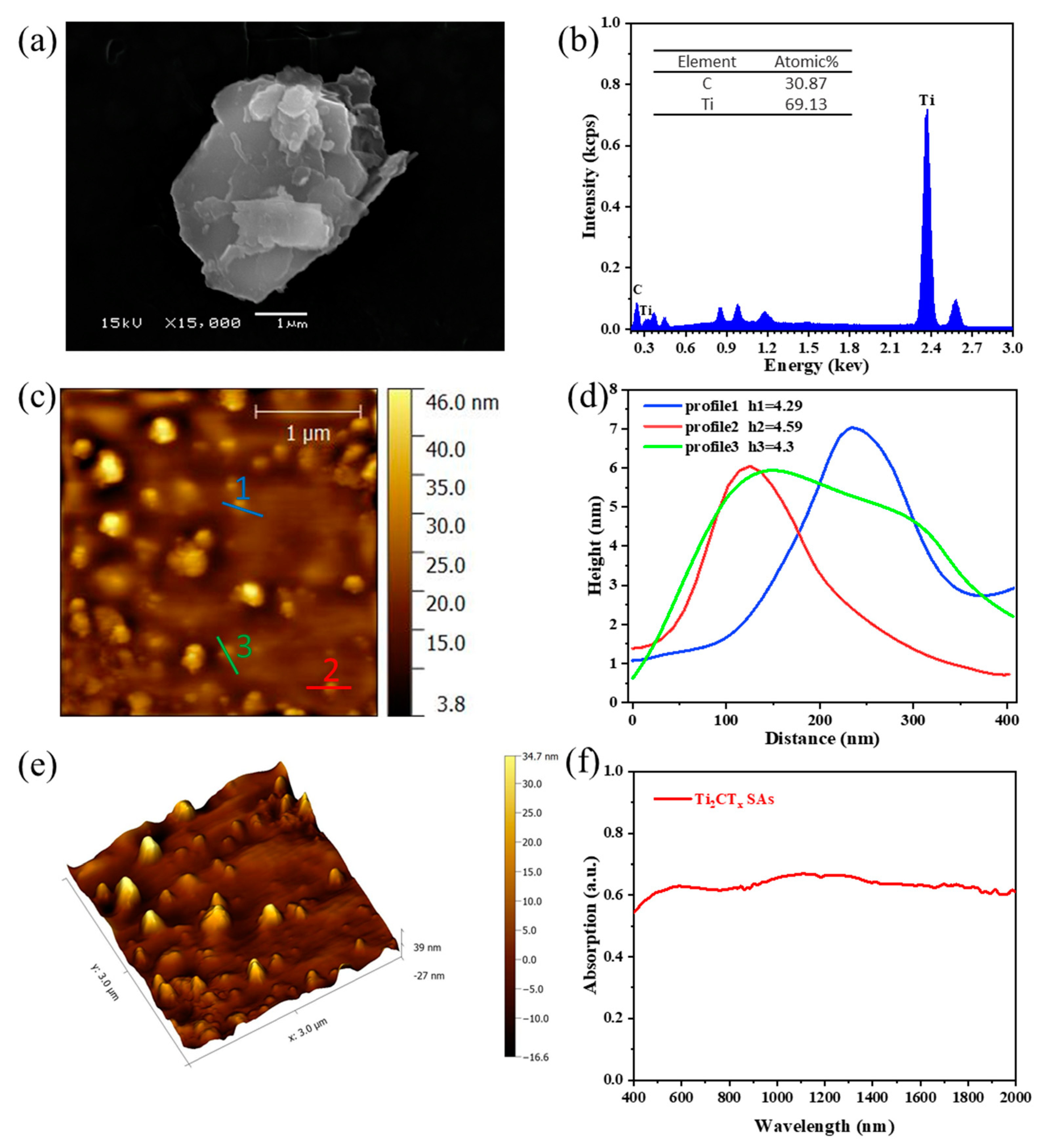
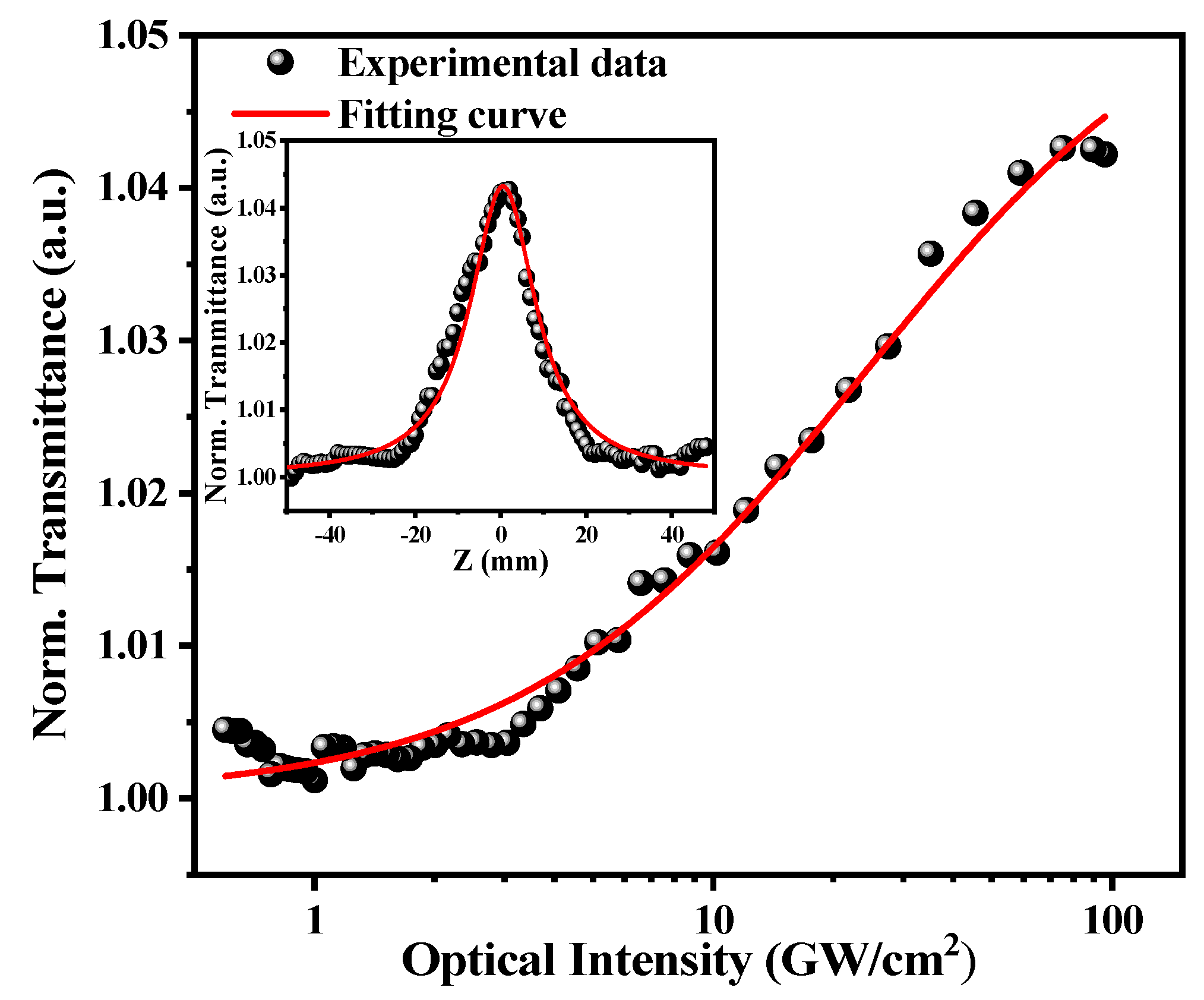
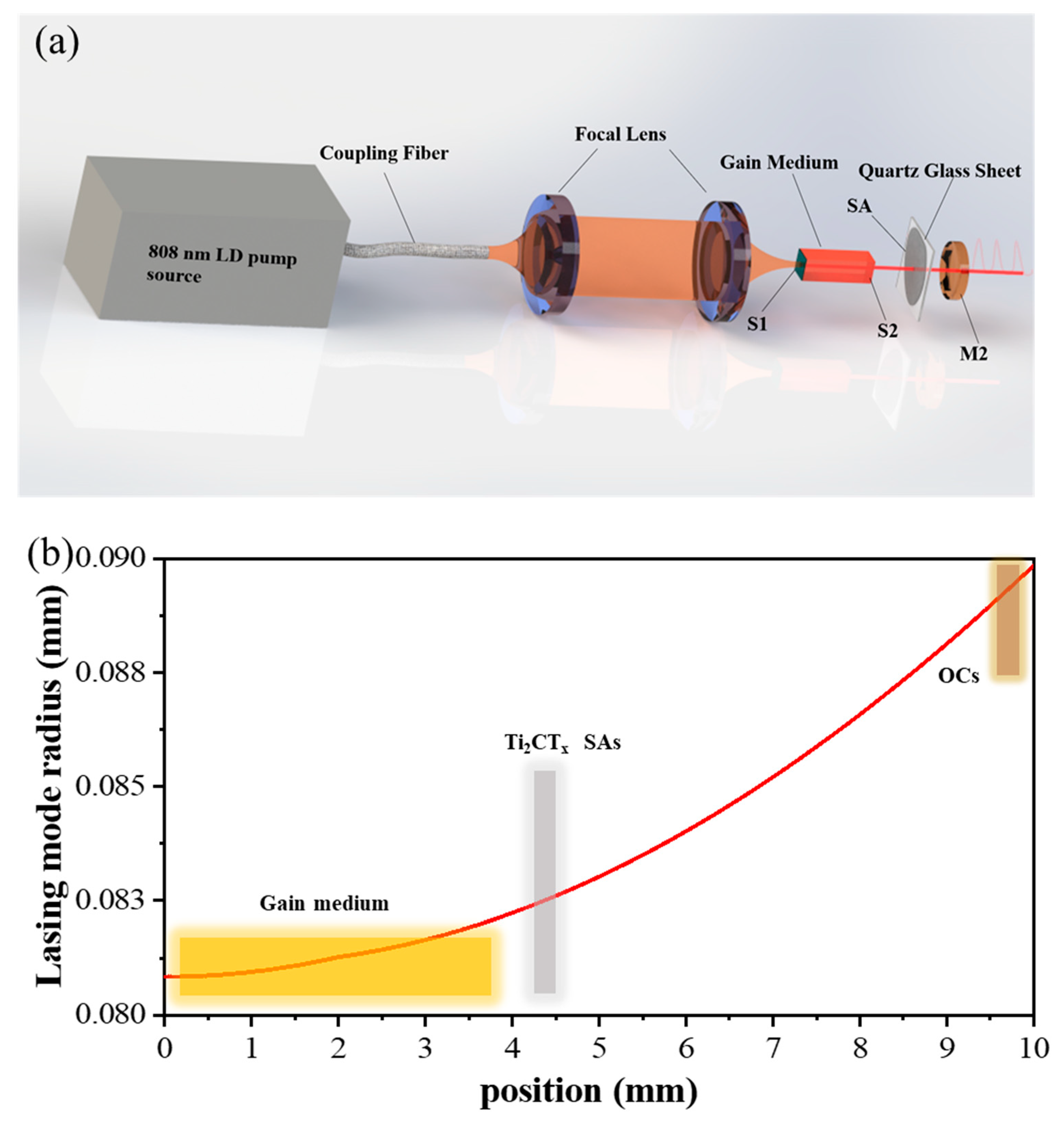

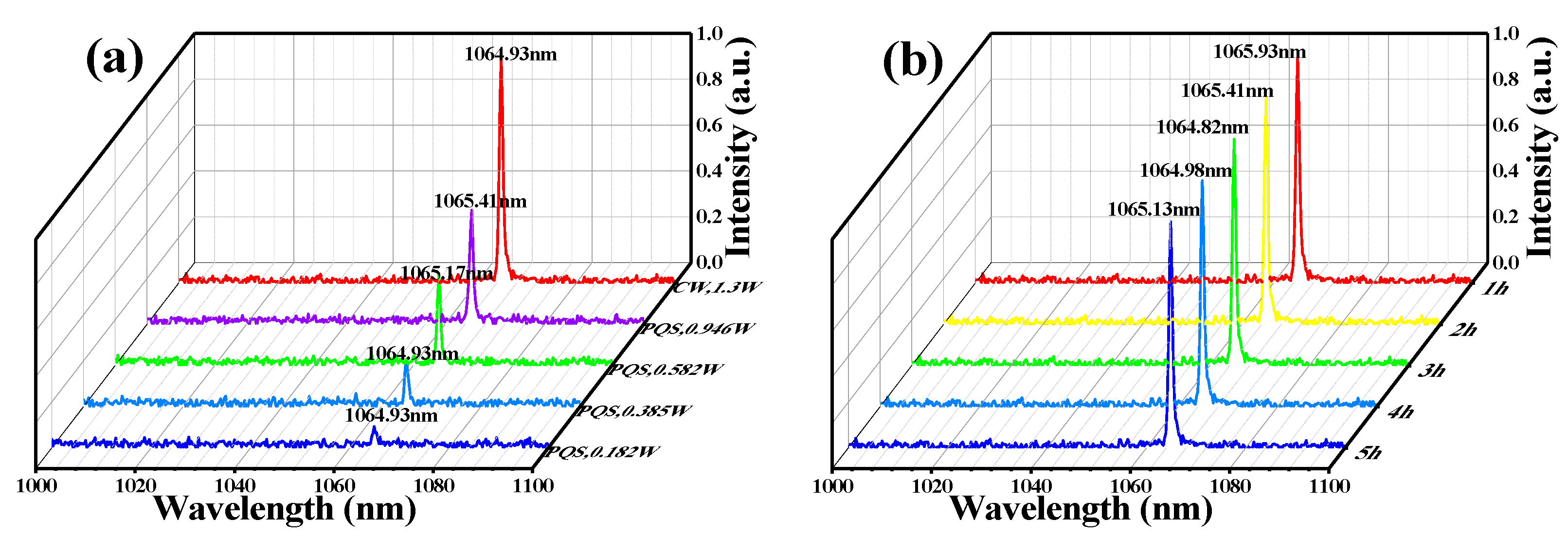
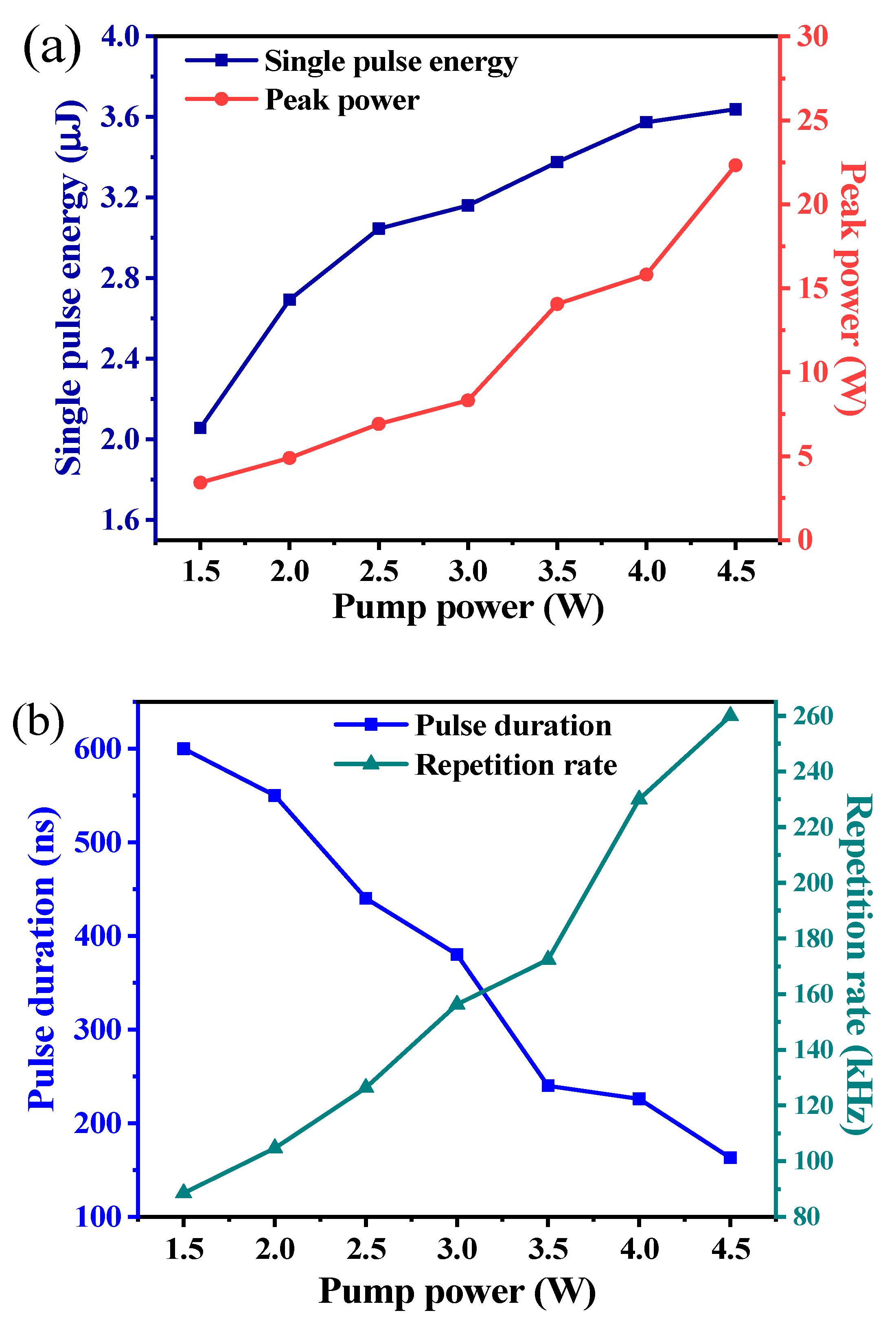
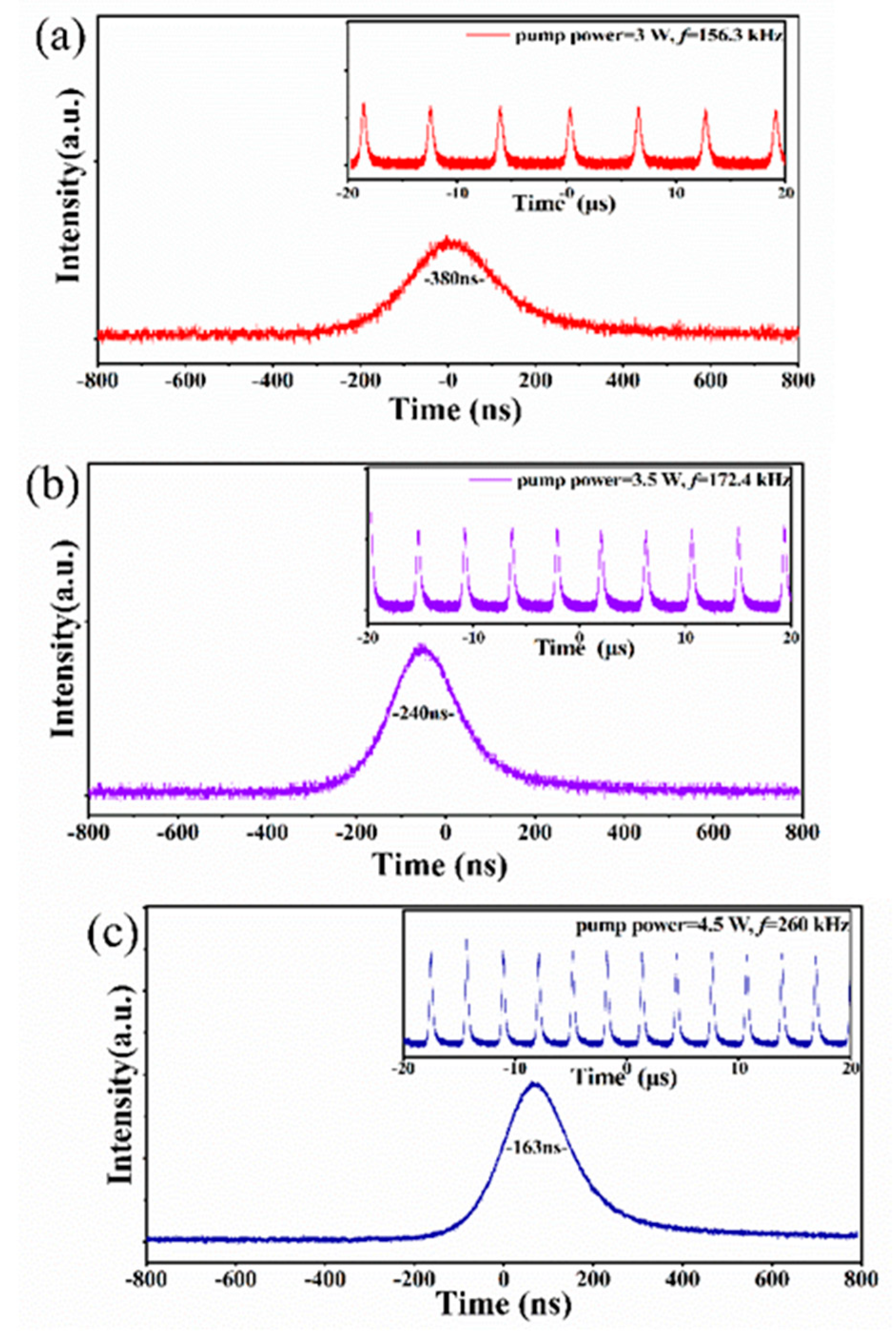

| SAs | Λ (nm) | Laser Type | Τ (ns) | F (kHz) | P (mW) | ESP (μJ) | PP (W) | ε | Ref. | |
|---|---|---|---|---|---|---|---|---|---|---|
| Graphene | 1064 | Nd:GdVO4 | 104 | 600 | 1220 | 2.03 | 19.52 | 12.2% | [50] | |
| Black phosphorus | 1064 | Nd:GdVO4 | 495 | 312 | 22 | 0.07 | 0.141 | 3.7% | [51] | |
| TIs | Bi2Te3 | 1064 | Nd:YVO4 | 2000 | 151.5 | 170 | 1.122 | 0.561 | 3.2% | [52] |
| Bi2Se3 | 1064 | Nd:GdVO4 | 666 | 547 | 32 | 0.058 | 0.087 | 1.7% | [53] | |
| TMDs | ReS2 | 1064 | Nd:YAG | 139 | 644 | 120 | 0.186 | 1.34 | 12.6% | [54] |
| MoS2 | 1064 | Nd:GdVO4 | 970 | 732 | 227 | 0.31 | 0.32 | 8.3% | [55] | |
| MXene | Ti3C2Tx | 639 | Pr:LiYF4 | 264 | 163 | 150 | 0.92 | 3.48 | 6.0% | [56] |
| 1049 | Nd:SRA | 346 | 201 | 130 | 0.65 | 1.87 | 4.6% | [57] | ||
| 1064 | Nd:YAG (ceramic) | 359 | 186 | 94.8 | 0.66 | 2.04 | 2.3% | [58] | ||
| 1300 | Nd:YVO4 | 454 | 162 | 30 | 0.2 | 0.406 | 0.6% | [59] | ||
| 2100 | Ho:YLF | 837 | 35.5 | 341 | 20.8 | 7.43 | 13.3% | [60] | ||
| 2730 | Er:CaF2-SrF2 | 814 | 45.3 | 286 | 6.32 | 7.76 | 10.6% | [61] | ||
| 2950 | Ho, Pr:LLF | 266.7 | 83.24 | 105 | 1.26 | 4.73 | 4.5% | [62] | ||
| Mo2CTx | 1064 | Nd:YAG | 136 | 261 | 547 | 2.09 | 15.41 | 9.7% | [63] | |
| 1342 | Nd:YVO4 | 222 | 236 | 236 | 1.41 | 6.36 | 3.1% | [63] | ||
| Ti4N3Tx | 2850 | Er:Lu2O3 | 278.4 | 113.7 | 778 | 6.84 | 24.57 | 10.5% | [34] | |
| hybrid Ti3C2(OH)2/ Ti3C2F2 | 1064 | Nd:YVO4 | 130 | 508 | 620 | 0.6 | 4.35 | 12.2% | [35] | |
| 1340 | Nd:YVO4 | 390 | 195 | 480 | 2.45 | 6.25 | 18.1% | [35] | ||
| Ti2CTx | 1064 | Nd:YAG | 163 | 260 | 946 | 3.638 | 22.32 | 21% | This work | |
Publisher’s Note: MDPI stays neutral with regard to jurisdictional claims in published maps and institutional affiliations. |
© 2021 by the authors. Licensee MDPI, Basel, Switzerland. This article is an open access article distributed under the terms and conditions of the Creative Commons Attribution (CC BY) license (http://creativecommons.org/licenses/by/4.0/).
Share and Cite
Huang, H.; Wang, J.; Xu, N.; Liu, S.; Liang, G.; Wen, Q. Ti2CTx MXene as a Saturable Absorber for Passively Q-Switched Solid-State Lasers. Polymers 2021, 13, 247. https://doi.org/10.3390/polym13020247
Huang H, Wang J, Xu N, Liu S, Liang G, Wen Q. Ti2CTx MXene as a Saturable Absorber for Passively Q-Switched Solid-State Lasers. Polymers. 2021; 13(2):247. https://doi.org/10.3390/polym13020247
Chicago/Turabian StyleHuang, Hongfu, Jianwen Wang, Ning Xu, Shunxiang Liu, Guowen Liang, and Qiao Wen. 2021. "Ti2CTx MXene as a Saturable Absorber for Passively Q-Switched Solid-State Lasers" Polymers 13, no. 2: 247. https://doi.org/10.3390/polym13020247
APA StyleHuang, H., Wang, J., Xu, N., Liu, S., Liang, G., & Wen, Q. (2021). Ti2CTx MXene as a Saturable Absorber for Passively Q-Switched Solid-State Lasers. Polymers, 13(2), 247. https://doi.org/10.3390/polym13020247








